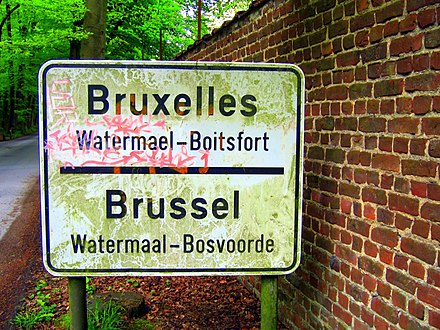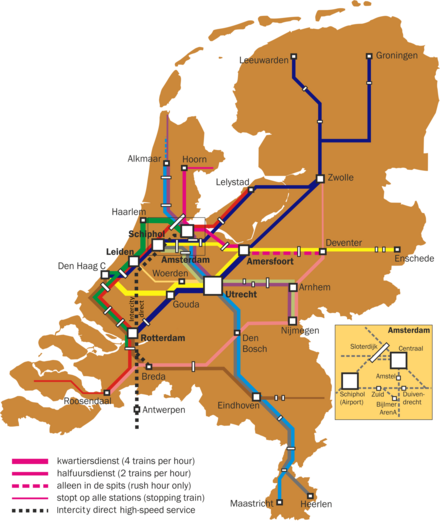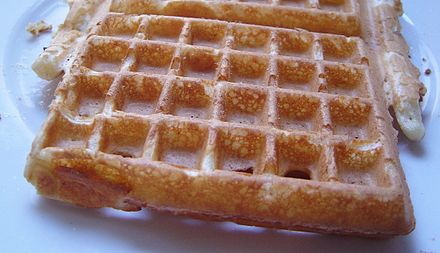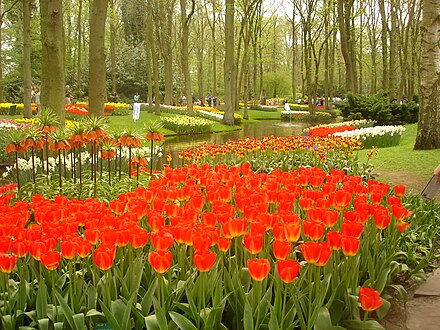Benelux
Benelux
Benelux is an economic union comprising three neighbouring monarchies: __Be__lgium, the __Ne__therlands, and __Lux__embourg . The name is formed from the beginning of each country's name. It was a precursor of the European Union.
The region is more traditionally known in English as the Low Countries because they are all part of a plain near the North Sea, and parts of the Netherlands are so low as to actually be below sea-level, requiring dykes to keep the sea water out. The three countries share a number of commonalities, starting from their topography and climates, which in turn influenced their cultures and economies, from the fish-and-potatoes nature of the cuisine to the famous renaissance art. But this has also traditionally been a land divided: with the Netherlands being a majority-Protestant country, while Belgium and Luxembourg were Catholic; as well the Netherlands and the northern half of Belgium (Flanders) are Dutch-speaking, while southern Belgium is French-speaking. Yet, all being small countries wedged between the massive and nationalistic states of France and Germany, they have shared a similar tragic modern history of invasion and occupation. This shared history galvanized the countries to become major founders and joiners of international organisations in the post-war era in the hope of ending the threat of invasion. Nowadays, thanks to their reputation as honest brokers and their "neutral location" between France and Germany, these countries are the home to numerous international institutions, almost like a giant "capital district" for all of Europe. Examples include the international court in the Hague or the EU headquarters shared between Brussels and Luxembourg City. With all this international attention, these countries have developed some of the best-developed travel infrastructure in the world, including efficient airports, extensive rail networks, and a full range of hotels and restaurants from cheap and cheerful to chic and elegant. This is a perfect gateway into Continental Europe for those taking their first steps. Everything is relatively safe and easy to navigate, and many people speak passable English. Distances between cities are small, and those cities are compact and walkable.
Countries

A flat country that is constantly being changed by the seas. Inventive minds in Dutch history developed a technique for claiming land back from the ocean.
The battlefield for World War I, this picturesque country is known for its culinary specialties and hosts many important institutions of the European Union.
This small duchy once laid claims upon the entire Benelux region around 600 years ago.
Cities
- Amsterdam — traveller magnet due to its impressive architecture, lovely canals (grachten), museums and liberal attitudes
- Antwerp — a giant cathedral, medieval streets, artistic heritage, and the second-largest port of Europe, coined the Diamond of the Sea
- Brussels — unofficial capital of the EU with a nice historic centre and several museums
- Bruges — one of Europe's wealthiest cities in the 14th century, its large and beautiful historic centre remains intact; a romantic city with pre-Renaissance walls
- Liège — largest city of Wallonia (the French part of Belgium), along a wide river, industrial cityscape with hiking and resorts in the nearby hills
- Luxembourg — its spectacular valleys and plateaus led it to be nicknamed the "Gibraltar of the North"
- Rotterdam — modern architecture, good nightlife and the largest port of Europe, Rotterdam is a hub of excitement
- The Hague — seat of government, royal family, judicial capital of the world and Madurodam
- Utrecht — historic centre, nice antique stores and the Rietveld-Schröder House are all in this magnificent Dutch city
Other destinations
- Ardennes — The most sparsely populated in Benelux, this is a hilly countryside region covered with forests.
- Binche — For three days in February, the town is transported back to the 16th century for one of the most fantastic carnival festivals.
- Hoge Veluwe National Park — Largest national park with heathlands, sand dunes and woodlands.
- Keukenhof — Millions of tourists visit the tulip fields each Spring.
- Kinderdijk — These windmills show the typical Dutch landscape in all its glory.
- Pajottenland — An area of green fields and small villages, some of which have been portrayed by artists such as Pieter Bruegel.
- Schokland — Old island evacuated in 1859, a well-preserved ghost village remains.
- Vianden — Quaint small town presided over by a rather splendid château.
- Waterloo Battlefield — The Waterloo Battlefield where Napoleon lost the final battle that changed Europe's face forever.
Understand
Luxembourg and the East of Belgium are a hilly area, but the rest of the Benelux is what is known as the Low Countries; this is the delta of the rivers Scheldt, Meuse, Rhine and Ems that used to be swamp land. Enterprising fishermen discovered a flair for trade when trading routes started to emerge between the grain markets of the Baltic Sea and the renaissance-bitten luxury goods markets of northern Italy. Here is where stocks were invented. Trade in all kinds of goods as well as enslaved humans made a small elite incredibly rich and the Dutch East India Company (VOC for its Dutch name) became one of the first multinational stock based companies and in its heyday controlled entire countries.
This attention to trade made Bruges one of the largest cities in Europe in its day, and the medieval old town is still well preserved. When the secession war with Spain progressed, French and Flemish alike fled to Amsterdam, which became the new world capital of trade, which is still witnessed in the many 'Houses of the Lords' lining the famous canals.
Talk
 Dutch is the main language in the Netherlands and in the north of Belgium (Flanders) where it is also known as Flemish, and is also one of the two official languages of Brussels, spoken by about 15% of its inhabitants. French is the main language (85%) in Brussels, and in all of the South of Belgium (Wallonia) with the exception of the eastern side of Wallonia where you will find the Belgian German speaking community. In Belgium, while most Dutch speakers can speak reasonable French, few Belgian francophones speak Dutch, which has caused political tension in the country. Luxembourg has three official languages: Luxembourgish, French and German, but for all practical purposes French is the most important language for travelers.
Dutch is the main language in the Netherlands and in the north of Belgium (Flanders) where it is also known as Flemish, and is also one of the two official languages of Brussels, spoken by about 15% of its inhabitants. French is the main language (85%) in Brussels, and in all of the South of Belgium (Wallonia) with the exception of the eastern side of Wallonia where you will find the Belgian German speaking community. In Belgium, while most Dutch speakers can speak reasonable French, few Belgian francophones speak Dutch, which has caused political tension in the country. Luxembourg has three official languages: Luxembourgish, French and German, but for all practical purposes French is the most important language for travelers.
Many people, especially in the Netherlands and Flanders, the Dutch-speaking part of Belgium, have a very high proficiency of English, and younger people often have near native fluency. This is because foreign television content is aired in its original language, with subtitles. On the other hand, in French-speaking Wallonia, TV is dubbed into French and people hence do not speak English so well. Frisian is a minority language spoken in Friesland (Netherlands).
As Dutch is very close to German, you will be understood with difficulty by most Dutch speakers if you speak German, but not all of them will necessarily speak more than a handful of German phrases themselves.
Get in
By plane
Most people get into the Benelux region by plane or train. Schiphol Airport in Amsterdam and Zaventem Airport in Brussels are the largest airports in the region; Schiphol is also important as a transfer airport for further destinations in Europe. Smaller airports are present in Antwerp, Eindhoven, Groningen, Luxembourg, Maastricht, Charleroi ("Brussels South"), Liège and Rotterdam, which are mostly used by no-frills airlines.
By train
High-speed rail networks connect the Benelux with France, Germany, and the United Kingdom (through the Channel Tunnel). High-speed trains operated by Thalys connect Paris with Brussels, Antwerp, Rotterdam, and Amsterdam in a little more than three hours. High-speed (and slower intercity) ICE International trains operated by Deutsche Bahn (dead link: January 2023) (and Nederlandse Spoorwegen) connect Frankfurt (and Cologne) with Amsterdam and Brussels, and Basel with Amsterdam. High-speed trains operated by Eurostar connect London with Brussels, Rotterdam and Amsterdam.
By bus
The major companies running Intercity buses in Germany all serve stations in the Benelux as well. France liberalized its long distance bus market in 2015, and connections to major cities in the Benelux have either been announced or are planned. Some buses even take you to London, either through the Channel Tunnel or by being loaded on a car ferry.
Get around
As this is a densely populated area in Europe you usually have the choice of several modes of transport and getting around should be a breeze, if sometimes a bit hard on the wallet.
By train
 All major towns (and many minor ones) are connected to the rail network. Belgium alone has four high-speed rail lines, though they mostly serve trains coming from or going to other countries. Within the region trains are reasonably fast, cheap (in Belgium keeping rail travel affordable is officially stated public policy and their per passenger km subsidy is the highest in Europe) and have frequencies of once an hour or more often. All three rail companies (including the tiny CFL (dead link: January 2023) of Luxembourg) serve international routes. The Beligan railways website is available in several languages and local varieties, including for the US and most European countries. Public transport in the Netherlands can be planned utilizing the public transport journey planner 9292.nl. Train tickets for the national railway service are cheapest when bought online, through their app or by using the countrywide public transport smartcard.
All major towns (and many minor ones) are connected to the rail network. Belgium alone has four high-speed rail lines, though they mostly serve trains coming from or going to other countries. Within the region trains are reasonably fast, cheap (in Belgium keeping rail travel affordable is officially stated public policy and their per passenger km subsidy is the highest in Europe) and have frequencies of once an hour or more often. All three rail companies (including the tiny CFL (dead link: January 2023) of Luxembourg) serve international routes. The Beligan railways website is available in several languages and local varieties, including for the US and most European countries. Public transport in the Netherlands can be planned utilizing the public transport journey planner 9292.nl. Train tickets for the national railway service are cheapest when bought online, through their app or by using the countrywide public transport smartcard.
By bus
Flixbus runs domestic buses in the Netherlands.
By car
All countries in the Benelux have a reasonably dense highway network. There is a default speed limit of 130 km/h in the Netherlands and Luxembourg and of 120 km/h in Belgium. As is prescribed by law those speed limits will be shown in a standardised form on every road entrance to the country in question.
By bike
The Netherlands - and to a lesser extent Belgium and Luxembourg - are positively bike crazy. There are more bikes than people and every city of any size has a decent or excellent network of bike routes that is patronized by locals of all ages shapes and socioeconomic classes. The only caveat when it comes to cycling is the fact that bikes may be stolen in bigger cities. Intercity cycling is less common but still possible, due to the flat nature of most of the terrain.
See

 Much of the swamp land in the Low Countries has been reclaimed, resulting in some of the largest water works in the world, such as the Delta Works, and in other attractions such as the windmills of Kinderdijk in South Holland. Much has not been reclaimed, resulting in interesting biotopes, such as the Zwin on the North Sea Coast of Belgium and the area around the Wadden Sea in the North of the Netherlands.
Much of the swamp land in the Low Countries has been reclaimed, resulting in some of the largest water works in the world, such as the Delta Works, and in other attractions such as the windmills of Kinderdijk in South Holland. Much has not been reclaimed, resulting in interesting biotopes, such as the Zwin on the North Sea Coast of Belgium and the area around the Wadden Sea in the North of the Netherlands.
- Look at some of the region's historic cities, including Amsterdam, Antwerp, Bruges, Delft, Ghent, and Maastricht
- Brussels is the so-called capital of the European Union; take a wander through the European Quarter with its modern architecture
- The Netherlands has a bewildering amount of art museums—at least chip in the Museum Quarter in Amsterdam
- Cheese markets are a big thing in Holland—Alkmaar, Edam, and Gouda have them
- More Dutch stereotypes are to be found elsewhere; windmills in Zaanse Schans, tulips in the Keukenhof, and flat polders in the Green Heart
- Flanders has many beguinages and belfries—a total of 46 have been inscribed in the UNESCO World Heritage List
- The Delta Works, one of the most technologically advanced projects in the world, give an insight in the Dutch' centuries-long battle against the sea
- So, what to see in Luxembourg? Try its capital of the same name, with a splendid location high on a cliff, or Vianden, a tourist favourite with its stunning mediaeval Beaufort Castle.
Do
- You will find white-water canoeing in Luxembourg and the East of Belgium.
- There are some excellent golf courses in Luxembourg and the East of Belgium.
- Rent a bike and explore Amsterdam.
- Visit the smallest town in the world, Durbuy, in the Ardennes.
Eat
 While the Netherlands, Belgium and Luxembourg are cosmopolitan in their eating habits and have many fine dining venues, they have some distinct culinary traditions and are also influenced by the neighboring larger countries of France and Germany.
While the Netherlands, Belgium and Luxembourg are cosmopolitan in their eating habits and have many fine dining venues, they have some distinct culinary traditions and are also influenced by the neighboring larger countries of France and Germany.
The Netherlands
Food in the Netherlands is traditionally based on meat, fish or cheese, with potatoes or bread as a staple, and few spices. The Dutch national dish is stamppot, potatoes mashed with one or several vegetables. While breakfast and lunch are made up of bread and cold cuts, dinner is typically a hot meal.
The Netherlands are a forerunner in industrial agriculture, and one of Europe's main exporters of dairy, meat and vegetables.
Indonesian cuisine has a large presence in the Netherlands, most notably in the form of the rijstaffel, an elaborate banquet comprising of dishes from across the archipelago that was developed for the Dutch colonists in what was then the Dutch East Indies. While the tradition died out in Indonesia after independence, it was brought back to the Netherlands by the returning colonists, and is what Dutch people usually envision when they think of Indonesian food, although authentic Indonesian food such as Indonesians eat is also readily available in the Netherlands.
There is also some delicious New Dutch food in upscale restaurants.
North American fast food and the Middle Eastern cuisine are also widespread.
Belgium and Luxembourg
Belgium is at the crossroads between Germanic and French culture. Moules et frites/Mosselen met friet, mussels with French fried potatoes, is one of the best-known dishes. And despite being called "French fries" in English, they are really Belgian fries, and traditionally dipped in mayonnaise.
Luxembourg is famous for judd mat gaardebounen, smoked pork neck with beans.
Desserts
For dessert, in the Netherlands, try stroopwafels, the famous cookies from Gouda or almond fingers, rich with sugar and marzipan.
In Belgium, keep in mind that their chocolate is some of the best on the planet, and they are also famous for waffles, particularly Liège and Brussels waffles.
Drink
Belgium and the Netherlands are famous for their beer, especially tasty lager beer.
Stay safe
The Benelux is a safe area in general. Some specific areas (usually in urban areas) might require extra vigilance, but you will not need to fear for your life.
Go next
Possible day-trips include the historic cities of Lille and Aachen, that are just over the border in France and Germany, respectively. Many Europe-trippers take the train to Berlin with a possible de-tour of Quedlinburg on the way.
